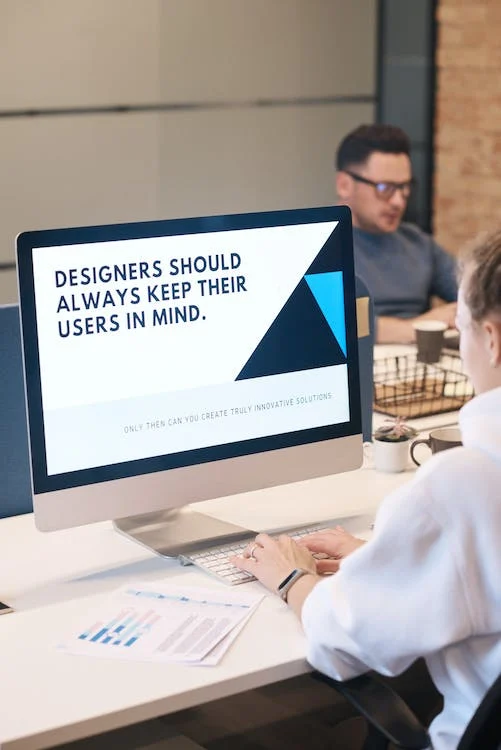Introduction to the Psychology of Web Design
In today’s digital age, understanding the psychology behind user behavior is crucial for web designers. The way users interact with a website is heavily influenced by their cognitive processes, emotions, and motivations. By harnessing this knowledge, designers can create user experiences that not only engage and satisfy users but also drive them towards specific actions.
The Role of Psychology in Web Design Psychology is the study of human behavior and mental processes. It’s a broad field that encompasses many different sub-disciplines, including cognitive psychology (which focuses on how people think), social psychology (which examines how people interact with one another), and developmental psychology (which looks at how people change over time).
Understanding User Behavior
To design experiences that resonate with users, it is essential to comprehend the underlying factors that influence their decision-making processes. Cognitive psychology provides insights into how users process information, make choices, and navigate through websites. By understanding these cognitive processes, designers can optimize their websites’ structure, layout, and content to facilitate seamless user interactions.
Emotions also play a significant role in user behavior. Designers can leverage emotions by incorporating visually appealing elements and using persuasive language to evoke specific feelings or responses. By understanding how emotions impact user experiences, designers can create designs that elicit positive emotions and encourage users to engage with the website.
Additionally, behavioral psychology sheds light on the role of motivation in user behavior. By identifying the intrinsic and extrinsic motivators that drive users, designers can tailor their websites to address these motivations. This might involve creating a rewards system, implementing gamification elements, or offering incentives to encourage users to perform desired actions.
Persuasive Web Design Techniques
To influence user behavior, web designers employ various persuasive techniques. Persuasive web design techniques refer to the strategic use of design elements, copywriting, and psychological principles to influence user behavior and drive specific actions. These techniques aim to persuade users to take desired actions, such as making a purchase, signing up for a newsletter, or sharing content on social media.
Persuasive web design techniques can include various tactics, such as:
Visual Cues
Placing visual elements, such as arrows or images of people looking towards a specific element, to direct users’ attention and guide them toward important information or calls to action.
Color and Typography
Leveraging the psychological impact of color and typography choices to create desired associations, evoke specific emotions, or emphasize key elements.
Scarcity and Urgency
Creating a sense of scarcity or urgency by highlighting limited-time offers, displaying countdown timers, or showing stock availability. This can instill a fear of missing out (FOMO) and prompt users to take immediate action.
Social Proof
Incorporating social proof elements, such as testimonials, user reviews, or statistics, to establish credibility and trust, assuring users that others have had positive experiences with the product or service.
Personalization
Tailoring the content or design of a website to reflect the user’s preferences or past behaviors. Personalization creates a more personalized and engaging experience, increasing the likelihood of user engagement and action.
Clear Calls to Action (CTAs)
Using concise and compelling copywriting for CTAs to communicate the desired action and create a sense of urgency or benefit for users.
Anchoring
Applying the principle of anchoring by presenting users with a higher-priced item or option first, making subsequent options seem more affordable or more attractive by comparison.
These techniques, when used ethically and strategically, can significantly influence user behavior and improve conversion rates on websites. However, it is important to balance persuasive techniques with a user-centered approach, prioritizing the overall user experience and ensuring that the design and messaging align with user expectations and needs.
The Role of User Experience (UX) in a Web Design
User Experience (UX) design is a critical aspect of web design, as it focuses on understanding users’ needs, goals, and behaviors to create meaningful, intuitive, and enjoyable website experiences. UX design considers all aspects of the user’s interaction with the website, from their first impression to their final action, aiming to create a satisfying and seamless journey throughout.
The role of UX design can be broadly categorized into the following:
User Research
Conducting user research to understand the target audience’s needs, preferences, and behaviors. This research helps UX designers create designs that resonate with users and offer meaningful solutions to their problems.
Information Architecture
Developing a clear website structure and content hierarchy to ensure that users can easily find the information they need. This includes designing clear site maps, navigation systems, and intuitive labeling systems.
Interaction Design
Creating intuitive and functional user interfaces and interactions that align with users’ mental models and expectations. This involves designing clear and recognizable icons, implementing intuitive user interactions, and creating functional and aesthetically pleasing designs.
Usability Testing
Evaluating the effectiveness and ease of use of the design by conducting usability testing, gathering user feedback, and applying insights gained to improve the website’s usability.
Visual Design
Creating visually appealing designs that align with the website’s brand and style while ensuring accessibility and usability across different devices.
Effective UX design can positively impact several website metrics such as user engagement, conversion rates, and customer satisfaction. By understanding and addressing users’ needs and pain points, UX designers can create an enjoyable and seamless website experience, building trust and loyalty with the user base.
Online UX Design Courses to Enhance Your Skills
If you are looking to enhance your skills in UX design and learn techniques to influence user behavior, online UX design courses can be invaluable resources. These courses provide comprehensive training in user research, information architecture, interaction design, and usability testing.
Platforms like Coursera, Udemy, and Interaction Design Foundation offer a wide range of UX design courses taught by industry experts. Engaging in these courses allows designers to acquire in-demand skills and stay updated with the latest trends and best practices in UX design.
To make the most out of an online UX design course, it is crucial to actively participate in the course material, complete practical exercises, and seek feedback from instructors or fellow students. By applying the knowledge gained from these courses, designers can confidently implement psychology-informed design strategies in their projects.
The Role of User Interface (UI) Design
User Interface (UI) design focuses on creating visually appealing and user-friendly interfaces. UI designers are responsible for creating the layout, typography, color schemes, and interactive elements that make up a website or application.
To influence user behavior, UI designers prioritize creating interfaces that are intuitive and easy to use. By adhering to user-centered design principles, designers ensure that the interface aligns with users’ mental models and expectations. This involves designing clear and recognizable icons, using consistent visual language, and implementing intuitive user interactions.

Conclusion
In conclusion, understanding the psychology of web design is essential for influencing user behavior. By considering cognitive processes, emotions, and motivations, web designers can create experiences that resonate with users and drive them towards desired actions. Persuasive web design techniques, combined with effective UX and UI design, can optimize user experiences and increase engagement.
Furthermore, embracing online UX design courses offers designers the opportunity to enhance their skills and acquire valuable knowledge in the field. By continuously improving their design capabilities and understanding of user psychology, designers can create impactful and user-centric web experiences that leave a lasting impression on their audience.

